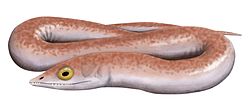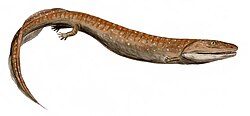| Palaeoherpeton Temporal range: Pennsylvanian, Westphalian A-B | |
|---|---|
| Scientific classification | |
| Domain: | Eukaryota |
| Kingdom: | Animalia |
| Phylum: | Chordata |
| Clade: | Sarcopterygii |
| Clade: | Tetrapodomorpha |
| Order: | † Embolomeri |
| Genus: | † Palaeoherpeton Panchen, 1970 |
| Type species | |
| Palaeogyrinus decorus Watson, 1926 | |
Palaeoherpeton is an extinct genus of eogyrinid embolomere which lived in the Pennsylvanian (late Carboniferous) of Scotland. It is primarily known from a series of relatively small but well-preserved skulls. Some of these have among the best braincase and middle ear material known in embolomeres. [1] Originally given the species name Palaeogyrinus decorus, this was later corrected to Palaeoherpeton decorum when it was determined that Palaeogyrinus was a name preoccupied by a genus of beetles. [2] [3]





